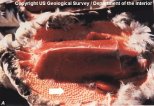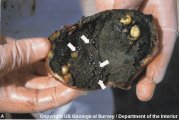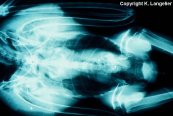|
|
| |
| Risk Factor |
-
Metallic lead is a highly toxic metal that, when ingested, affects many
organs and organ systems.
-
Wildlife are generally exposed to lead following ingestion of shot
pellets, bullet fragments, or lead fishing jigs and sinkers.
-
Before laws were introduced in North America to restrict the use of lead
in ammunition, annual losses of waterfowl to lead poisoning were up
to 3 million birds.
-
Compared to mammals and other species of birds, waterfowl and birds of
prey are at greater risk of exposure to lead because of feeding
habits that involve ingesting lead shot as grit or consuming lead
shot from the tissues of prey animals, respectively.
-
Lead poisoning has been mainly reported in birds but has also been
documented in wild mammals that presumably have fed upon
lead-contaminated prey.
|
| Images |
|
Click on
images to enlarge. |
 |
 |
 |
 |
|
Atrophy of breast muscles
and lack of observable fat is commonplace in lead-poisoned birds
(at arrow). |
Lead shot may be present
within the gizzard of lead-poisoned birds (at arrows). |
An
enlarged heart and metallic lead in
the gizzard (and shoulder) is visible in this lead-poisoned bald eagle. |
The feces of a lead-poisoned
bird are often bile-stained - bright green in color. Wings may
droop and birds may also appear listless. |
|
| Distribution and
Seasonality |
-
Lead exposure and poisoning has occurred throughout North America and may
occur throughout the year.
-
Historically, higher rates of exposure and poisoning in birds occurs
during the fall and winter coinciding with hunting seasons
where large amounts of lead shot were used.
|
|
| Mechanisms of Action |
-
In waterfowl, the highly muscular stomach grinds and erodes metallic lead
which then is rapidly distributed through the circulatory
system to other body tissues. Similar action occurs in birds
of prey which have less muscular but more acidic
stomachs than waterfowl.
-
Once absorbed within the body, lead can interfere with body functions
that rely heavily on the activity of calcium.
-
Lead interferes with the production of the oxygen-carrying component of
blood called hemoglobin, leading to a decreased ability of
red blood cells to carry oxygen.
-
Lead has also been documented to damage and modify the function of
kidneys, bone, nervous system, the circulatory system and
gastrointestinal tract.
-
If a sufficiently large
amount of metallic lead is ingested, death can be rapid
(acute poisoning); or, if a small
amount of lead is ingested, death may occur after several
weeks following
chronic ill-health.
|
|
| Signs and Symptoms |
-
Outward signs in birds include:
-
emaciation;
-
reduction in the size of
breast muscle, with the breast bone becoming prominent (referred
to as a hatchet-shaped breast);
-
lethargy
and lack of appetite;
-
head tremors;
-
esophagus impacted with
food, gizzard stained green;
-
green or bile-stained feces;
-
paralysis
of lower legs;
-
blindness;
-
impaired locomotion and
balance;
-
the head of some geese may
appear swollen;
-
drooping wings;
-
lack of fat in the abdominal
cavity;
-
metallic lead fragments may
be present in the stomach. The absence of such fragments in
lead-poisoned birds indicates that complete erosion and
subsequent absorption of the fragments may have occurred, that
the fragments were eliminated in the feces, or, in the case of
raptorial birds, voided in a regurgitate (pellet).
|
| Meat Edible? |
-
Game-bird hunters are aware that lead shot pellets are commonplace in
tissues of shot birds and deliberately avoid the pellets when the
bird is consumed.
-
Most of the lead present in lead-poisoned bird is in organs such as liver
and kidneys rather than in muscle. Although there is no appreciable
risk to human health from eating organs from a lead-poisoned bird,
it is not advisable to do so.
-
Dogs are at the same risk of exposure to metallic lead in hunter-killed
game meat.
|
| Risk Reduction |
-
As of 1999, Canadian law prohibits the use of lead shot for hunting
migratory birds such as ducks, geese (Anatidae), thick-billed
murres (Uria lomvia),
cranes (Gruidae), rails (Rallidae), gallinules (Rallidae) and coots
(Fulica americana), and common snipe (Gallinago gallinago). Restrictions have also been made on the use of
lead fishing sinkers and jigs. For further information regarding the
environmental effects of lead on wildlife in Canada,
click
here.
-
The ban on using lead shot
for hunting migratory birds should decrease the annual losses;
however, metallic lead remains in the environment for years, thus
allowing lead deposited prior to the government bans to be available
to feeding birds.
-
More recently, in the Fraser
Valley of British Columbia and Northern Washington, trumpeter swans
(Cygnus buccinator) have
died from lead poisoning in large numbers. Intensive studies by the
Canadian Wildlife Service and counterparts from Washington are now
underway to address this problem. For more information,
click here (PDF file).
|
| Samples for Diagnosis |
-
After death, lead levels in the liver and kidneys are typically used to
determine the extent of exposure.
-
Whole birds should be submitted for analysis; however, the entire liver
or kidney can be submitted alone. Liver or kidney samples should be
wrapped in tin foil and submitted frozen.
|
| Further Reading |
|
|
|
|



